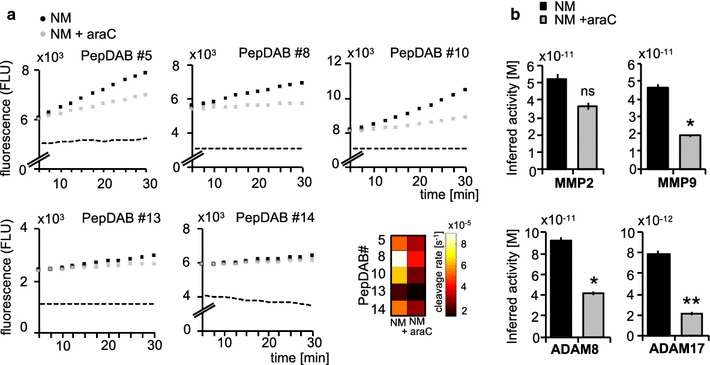Profiling of metalloprotease activities in cerebrospinal fluids of patients with neoplastic meningitis
- PMID: 28806983
- PMCID: PMC5556623
- DOI: 10.1186/s12987-017-0070-5
Profiling of metalloprotease activities in cerebrospinal fluids of patients with neoplastic meningitis
Abstract
Background: Neoplastic invasion into leptomeninges and subarachnoid space, resulting in neoplastic meningitis (NM) is a fatal complication of advanced solid and hematological neoplasms. Identification of malignant involvement of the cerebrospinal fluid (CSF) early in the disease course has crucial prognostic and therapeutic implications, but remains challenging. As indicators of extracellular matrix (ECM) degradation and breakdown of the blood-brain-barrier, Matrix Metalloproteases (MMPs) and A Disintegrin and Metalloproteases (ADAMs) are potential analytes for cerebral pathophysiology and metastatic dissemination of tumor cells into the CSF.
Methods: We compared protease activities in CSF samples from patients with NM and control individuals using FRET-based metalloprotease substrates with distinct enzyme selectivity profiles in a real-time, multiplex approach termed "proteolytic activity matrix assay" (PrAMA). Protease activity dynamics can be tracked by fluorescence changes over time. By simultaneously monitoring a panel of 5 FRET-substrate cleavages, a proteolytic signature can be identified and analyzed to infer the activities of multiple specific proteases. Distinct patterns of substrate cleavage comparing disease vs. control samples allow rapid, reproducible and sensitive discrimination even in small volumes of CSF.
Results: Individual substrate cleavage rates were linked to distinct proteases, and PrAMA computational inference implied increased activities of MMP-9, ADAM8 and ADAM17 (4-5-fold on average) in CSF samples from NM patients that were inhibitable by the metalloprotease inhibitor batimastat (BB-94). The activities of these proteases correlated with blood-brain barrier impairment. Notably, CSF cell counts were not found to directly reflect the protease activities observed in CSF samples from NM patients; this may explain the frequent clinical observation of negative cytology in NM patients.
Conclusion: PrAMA analysis of CSF samples is a potential diagnostic method for sensitive detection of NM and may be suitable for the clinical routine.
Keywords: CSF; FRET-substrates; Metalloproteases; Neoplastic meningitis; Real-time protease activities.
Figures




Similar articles
-
Proteolytic Activity Matrix Analysis (PrAMA) for simultaneous determination of multiple protease activities.Integr Biol (Camb). 2011 Apr;3(4):422-38. doi: 10.1039/c0ib00083c. Epub 2010 Dec 23. Integr Biol (Camb). 2011. PMID: 21180771 Free PMC article.
-
Simultaneous Detection of Metalloprotease Activities in Complex Biological Samples Using the PrAMA (Proteolytic Activity Matrix Assay) Method.Methods Mol Biol. 2017;1574:243-253. doi: 10.1007/978-1-4939-6850-3_18. Methods Mol Biol. 2017. PMID: 28315256
-
Matrix metalloprotease-9 in cerebrospinal fluid correlates with disease activity in lymphomatous meningitis.Clin Lymphoma Myeloma. 2007 Jan;7(4):305-8. doi: 10.3816/CLM.2007.n.007. Clin Lymphoma Myeloma. 2007. PMID: 17324339
-
Flow cytometry as a diagnostic tool in lymphomatous or leukemic meningitis: ready for prime time?Cancer. 2012 Apr 1;118(7):1747-53. doi: 10.1002/cncr.26335. Epub 2011 Oct 24. Cancer. 2012. PMID: 22025088 Review.
-
Proteomic Substrate Identification for Membrane Proteases in the Brain.Front Mol Neurosci. 2016 Oct 13;9:96. doi: 10.3389/fnmol.2016.00096. eCollection 2016. Front Mol Neurosci. 2016. PMID: 27790089 Free PMC article. Review.
Cited by
-
New Frontiers in Diagnosis and Therapy of Circulating Tumor Markers in Cerebrospinal Fluid In Vitro and In Vivo.Cells. 2019 Oct 2;8(10):1195. doi: 10.3390/cells8101195. Cells. 2019. PMID: 31581745 Free PMC article. Review.
-
Degradome of soluble ADAM10 and ADAM17 metalloproteases.Cell Mol Life Sci. 2020 Jan;77(2):331-350. doi: 10.1007/s00018-019-03184-4. Epub 2019 Jun 17. Cell Mol Life Sci. 2020. PMID: 31209506 Free PMC article.
-
Leptomeningeal carcinomatosis in gastric cancer: A Review.Gastric Cancer. 2025 May;28(3):311-325. doi: 10.1007/s10120-025-01597-8. Epub 2025 Mar 14. Gastric Cancer. 2025. PMID: 40085270 Free PMC article. Review.
-
Role of aging in Blood-Brain Barrier dysfunction and susceptibility to SARS-CoV-2 infection: impacts on neurological symptoms of COVID-19.Fluids Barriers CNS. 2022 Aug 18;19(1):63. doi: 10.1186/s12987-022-00357-5. Fluids Barriers CNS. 2022. PMID: 35982454 Free PMC article. Review.
-
Neoplastic meningitis in solid tumors: from diagnosis to personalized treatments.Ther Adv Neurol Disord. 2018 Mar 7;11:1756286418759618. doi: 10.1177/1756286418759618. eCollection 2018. Ther Adv Neurol Disord. 2018. PMID: 29535794 Free PMC article. Review.
References
MeSH terms
Substances
LinkOut - more resources
Full Text Sources
Other Literature Sources
Medical
Research Materials
Miscellaneous

